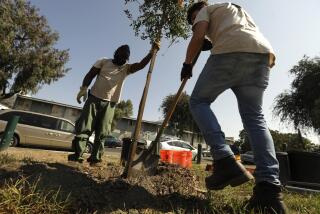Hong Kong Desires Roots for Its Trees
- Share via
HONG KONG — When the British came to Hong Kong in the 19th century, they famously described it as a “barren rock.”
They weren’t exactly right.
Hong Kong has more than 400 native varieties of trees, and traditional Chinese villages scattered around the territory at the time were built next to areas known as “feng shui woods,” where trees were seen as spiritual protectors of the people.
It was, and by tradition still is, forbidden to cut such trees, which are likened to guardian angels that provide shelter from winter winds, shade from summer skies and safety from landslides.
But much of Hong Kong was barren after centuries of people chopping away many of the trees that used to cover the entire territory, and conservationists say the generations that have been replanting it ever since have largely ignored the trees put here by nature.
Now, they worry that some of Hong Kong’s natural trees are on the verge of disappearing as property developers and city planners opt for exotic species that are easier to grow or known for more beautiful flowers.
“It’s quite unfair to native species -- they are in general better adapted to the local environment,” said Ken So, a conservation officer at the Kadoorie Farm and Botanic Garden research institute.
Conservationists at Kadoorie have been trying to germinate seedlings collected from native tree species and replant them in the wild, hoping that they can reverse what some see as an otherwise inevitable decline of Hong Kong’s native trees.
Since the program started with 15,000 seedlings from 50 species five years ago, the collection at Kadoorie has expanded to 100,000 seedlings from 180 species, So said.
The seedlings normally stay at the nursery for a year before being distributed to universities, government departments, schools and commercial developments for greening, landscaping and research.
An outstanding example was on Hong Kong’s highest mountain, Tai Mo Shan, where researchers planted 500 seedlings from five native species.
“The environment is quite bad -- it’s very steep and exposed -- but within two to three years, the seedlings have grown to four or five times their original height, with some now reaching 2 meters [6.7 feet] tall,” So said.
In contrast, one biodiversity professor at the University of Hong Kong took aim at the government’s decision to spend $1.3 million to plant 100 foreign palm trees on an entry road to the Disneyland theme park now being built.
“It’s wasting taxpayer’s money,” said Billy Hau, an assistant professor who has childhood memories of the feng shui trees near the 900-year-old village where he grew up.
The high-priced trees leading into Disneyland will create an image that’s not real Hong Kong -- with 26-foot palm trees that originally came from Spain’s Canary Islands but were grown in Australia.
“Foreigners often have a misconception, thinking Asia must have tall palms and coconuts, but what we have here are only the small ones,” Hau said. “It would give Disney visitors a unique flavor of South China if we plant native Chinese banyan instead.”
The government defends its decision -- and the hefty tree bill -- as the right way to make the park look more like Disney’s flagship in Southern California.
Hau and other green advocates fear that the local subtropical trees may vanish completely as Hong Kong puts up colorful or hardier exotic varieties -- in public squares, along roadsides and highways, and even in country parks where urban dwellers escape for a taste of nature.
Conservationists say some Hong Kong trees are almost gone already, with some species down to just one, although most trees found naturally here are also thriving across the border in China’s Guangdong province, so they aren’t on the verge of extinction.
The naturalists say local birds and animals have problems with some imported species.
Walking through older districts full of Hong Kong’s orchid trees, or bauhinias, one finds birds flocking and chirping everywhere. The bauhinia is Hong Kong’s official flower -- it is featured on the red and white Hong Kong flag and replaced the head of Britain’s Queen Elizabeth II on coins as the colonial period ended.
Now, many other areas are full of the easily grown Taiwan acacia. But don’t go looking for birds in that tree’s thin canopy and weak branches -- they won’t be there.
“Native species demand a better environment,” said Patrick Lai, senior nature conservation officer at the Agriculture, Fisheries and Conservation Department. “They are not as tough; they are hard to grow or grow too slowly, so they aren’t able to prevent soil erosion.”
Containing loose soil is important for Hong Kong to stop landslides that have killed thousands of people through the years.
Lai said that when Hong Kong reforests its country parks, about half of the trees are imports, although about 70 native tree species are also used to make up the other half.
Conservationist So would like to see more.
“Many of the native species are very beautiful and can be used to green our environment as well as contain soils,” So said. “All we need are further studies and trials to explore their potential.”
More to Read
Sign up for Essential California
The most important California stories and recommendations in your inbox every morning.
You may occasionally receive promotional content from the Los Angeles Times.













